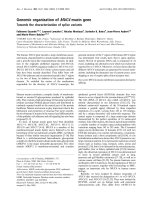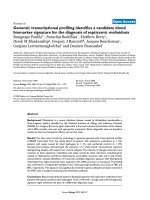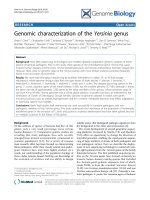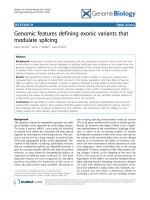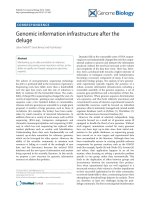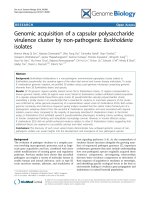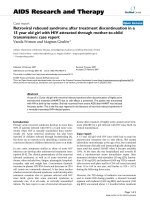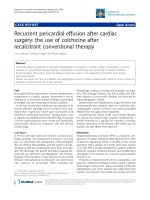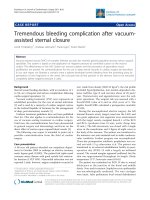Báo cáo y học: "Genomic information infrastructure after the deluge" pptx
Bạn đang xem bản rút gọn của tài liệu. Xem và tải ngay bản đầy đủ của tài liệu tại đây (312.6 KB, 5 trang )
e advent of next-generation sequencing technology
has led to a profound shift in the economics of genomics.
Sequencing costs have fallen more than a hundredfold
over the past four years, and this rate of reduction is
likely to continue for the foreseeable future. e availa-
bility of cheap DNA sequencing has changed the cost of a
variety of experiments - gaining a near-complete bacterial
sequence costs a few hundred dollars in consumables,
whereas mid-size genomes are amenable to a single grant
proposal. A number of large genomes, such as those of
vertebrates (for example, the turkey) have been under-
taken by small consortia of interested laboratories. In
addition, there are a variety of novel assays, such as RNA
sequencing (RNA-seq), transposon mutagenesis and
chromatin immunoprecipitation and sequencing (ChIP-
seq) in which low-cost sequencing has replaced other
readout platforms such as nucleic acid hybridization.
Under standing these data rests fundamentally on well
curated, up-to-date annotation for reference genomes,
which can be leveraged for other species. However, the
ability of the scientific community to maintain such
resources is failing as a result of the onslaught of new
data and the disconnect between the archival DNA
databases and the new types of information and analysis
being reported in the scientific literature. In this article,
we propose a new structure for genomic information
resources to address this problem.
Dramatic falls in the consumable costs of DNA sequen-
cing have not fundamentally changed the need for com pu-
ta tional analysis to process and interpret the infor mation
produced. Indeed, the need has increased as the volume
and complexity of the data have risen. ere has, there-
fore, been a profound shift towards a higher intensity of
informatics in biological research, with bio informatics
becoming a necessary component of many, if not most,
molecular biology groups. e analysis of new genome-
wide experiments typically requires the presence of a
robust, accurate information infrastructure, includ ing a
reasonable assembly of the genome sequence, a set of
accurate gene predictions and a description of their bio-
logical function. When genome sequence determina tion
was expensive, and thus both relatively uncommon and
concentrated in areas of intensive experimental research,
considerable resources could be focused on individual
genomes, often in intensively managed and curated model
organism databases (such as FlyBase [1], WormBase [2],
and the Saccharomyces Genome Database [3]).
However, the model of relatively independent, large
consortia focused on a small set of genomes seems ill
equipped to handle the flood of new genomes. Without
such support, annotations created for many genomes
have not been kept up-to-date since their initial sub-
mission to the public databases, as sequencing groups
have moved on to new targets and experimental data
have accumulated in the literature. Although there has
been considerable success in creating portable software
components for genome curation, such as the GMOD
tools (for example, Apollo [4] and Chado [5]), Artemis [6]
and others, their application happens in an ad hoc
manner, often focusing on solving a particular problem
specific to one group, rather than systematically. is
leads to the duplication of effort between groups and
inconsistency between the annotations they produce.
Even when experimental data are well organized in a
structured resource, their volume is a further impediment
to their successful exploitation by the wider community,
as network bandwidth is often a constraining factor when
attempting to download large datasets for analysis. ere
are, therefore, at least two challenges facing the post-
deluge community. e first is ensuring that bioinformatics
Abstract
Maintaining up-to-date annotation on reference
genomes is becoming more important, not less, as the
ability to rapidly and cheaply resequence genomes
expands.
© 2010 BioMed Central Ltd
Genomic information infrastructure after the
deluge
Julian Parkhill
1
*, Ewan Birney
2
and Paul Kersey
2
CO RRE SPO N DE N CE
*Correspondence:
1
The Wellcome Trust Sanger Institute, Wellcome Trust Genome Campus, Hinxton,
Cambridge, CB10 1SA, UK
Full list of author information is available at the end of the article
Parkhill et al. Genome Biology 2010, 11:402
/>© 2010 BioMed Central Ltd
resources are kept up-to-date and operate in a stable and
reliable funding environment. e second is creating
mechanisms to give end users access to the raw datasets,
which are now so massive that they cannot easily be
transferred across the Internet. Both are weighty issues,
and this article focuses on the first one.
e International Nucleotide Sequence Database
(INSDC), implemented as GenBank [7] at the US
National Center for Biotechnology Information (NCBI),
ENA at the European Bioinformatics Institute [8] (EBI)
and the DNA Database of Japan [9] at the National
Institute for Genetics, has archived DNA sequence infor-
ma tion submitted by experimentalists since its establish-
ment in 1984. However, even before the advent of the
new technology there was an increasing disconnection
between the genome annotation in the archive and the
more complex functional information that had accumu-
lated in the laboratories of the scientific community, and
in the literature. In response to this, the Ensembl project
[10] in Europe and the RefSeq project [11] at NCBI were
developed partly to capture, and partly to provide, high-
quality annotation, in particular on protein-coding genes,
on important genomes. For some species (such as
Drosophila, yeast and worm) these resources mirrored
information from the well funded model organism
databases already established for these species. In most
other cases, however, the new resources were derived from
a selection from the submitted archival records, with out
significant manual updates. Finally, in cases such as human
and other mammals, there was direct creation of added-
value datasets on the genome, often through collaborations
with other groups (for example, the UCSC Genome
Browser group [12] for vertebrate genomes). More
generally, NCBI [13] and EBI [14] act as major providers of
bioinformatics services across a broad range of domains,
of which genome-centric resources form just one part.
e current situation is therefore a patchwork of
different resources, with different funding models and
different communication lines. ere are benefits to this
diversity - funding streams usually involve a good
connec tion to the scientists working directly on a species
(whose involvement is required to justify investment), no
single group has a monopoly on the information flow,
innovation in added-value services can be explored, and
small additional components can often be funded rapidly.
However, there are some major disadvantages as well -
ineffective (or in some cases nonexistent) communication
between diverse groups hampers the propagation of the
best annotation through the system, while the diversity
and ad hoc nature of the tools requires large investments
by individual laboratories in just gathering, organizing
and reformatting data before conducting any pan-domain
analysis. Finally, the heterogeneous structure is very
confusing for funding agencies to engage with; it is
unclear what resources will appear without intervention,
unclear whether a particular resource is good value for
money (especially when it partially duplicates other
resources) and unclear how any particular information
resource will survive beyond a single funding cycle. In
addition, like many other scientific endeavors, these
activities occur in an international context with a geo-
graphic diversity of participating groups and a matching
diversity of funding agencies, whose goals may be more
or less well aligned.
e absence of a structure for funding and data can
lead to the loss of valuable scientific content when a
particular episode of funding concludes. Among the
most striking current demonstrations of this is the
funding crisis faced by e Arabidopsis Information
Resource (TAIR) [15], which has curated the genome of
the model plant Arabidopsis thaliana, but which faces
closure in 2013 if new funding cannot be secured. For
smaller resources, the threat of effective closure is ever
present, as funding is usually linked to specific research-
oriented grants. To give just one example, the COGEME
database for plant pathogen expressed sequence tags
(ESTs) [16] was updated regularly between 2001 and 2007
but (in the absence of longer-term funding) not since.
Over the past five years this patchwork of resources has
improved through communication and software reuse.
Examples include the development of open-source
software by groups such as GMOD (for example, the
Gbrowse genome browser [17]), Ensembl [10] and
GeneDB [18] that can be reused by others; better
communi cation between model organism databases and
EBI/NCBI; and improved coordination of funding in
adjacent areas (for example, the Bioinformatics Resource
Centers (BRCs) [19-21] funded by the US National
Institute of Allergy and Infectious Diseases (NIAID),
which each cover a portfolio of related species where
NIAID is also funding experimental work). However,
there is still a fundamental need for a stable, sustainable
and comprehensive configuration of resources that can
handle the growing influx of genomic data from all
sources. In the remainder of this article we outline a pro-
posed structure that formalizes aspects of current best
practice and proposes a clear model for data management
for both scientists and funding agencies.
A three-tier structure
We propose a three-tier, federated structure that should
address many of these issues (Figure1), in which each tier
has a different role and in which coordinated funding,
along with the movement of data between tiers, is
inherent in the design. Tier 1 represents data-generation
and analysis groups, which are funded to generate and
analyze data with the main goal of traditional scientific
publication. Tier 2 represents aggregators, which organize
Parkhill et al. Genome Biology 2010, 11:402
/>Page 2 of 5
data within a specific biological domain (these are likely
to be defined around a set of functionally or evolution-
arily related species). Resources in Tier 2 capture infor-
mation from Tier 1 groups working within their scope,
and cast this information into standardized forms (for
example, by assigning ontological terms), incorporate
specific high-throughput datasets into useful contexts
(for example, creating transcript structures on the
genome from RNA-seq data) and, crucially, update
reference annotation on the basis of the incorporated
data and the latest scientific literature. e integration
and interpretation of raw experimental data as reference
annotations has a further benefit - namely, a reduction in
data volume, making the data useable for a wider consti-
tuency of scientists. Finally, Tier 3 represents pan-domain
aggregators, which interact with datasets from multiple
Tier 2 resources to provide resources with a broader
scope (such as comparative genomics), and ensure the
repre sentation of information from the other tiers in the
primary public databases. Tier 3 resources are also
involved in the development of generic infrastructure
solutions to problems faced by diverse Tier 1 and Tier 2
resources, reducing the costs of parallel development and
subsequent integration. is sharing of software and data
model infrastructure between Tier 2 and Tier 3 providers
should also result in a more uniform end-user experience,
a consistent data model, and more opportunities to
integrate these resources via workflow tools like Galaxy
[22]. e attributes of each of the tiers are summarized in
Table1.
ese three tiers are not proposed to replace the
primary data archives such as the INSDC (for nucleotide
sequence), GEO [23] and ArrayExpress [24] (for
expression data), but rather to exist in parallel, providing
biological context to the archived data, which remains a
record of experiments that have been carried out. In
contrast, this stream of information represents the
scientific community’s best current understanding of
infor mation on these species. e specialization in terms
of biology decreases from Tier 1 to Tier 3, whereas the
sophistication in engineering and computation increases
from Tier 1 to Tier 3. is structure both provides for a
diversity of datasets and approaches (in particular Tier 1
and to some extent Tier 2) while ensuring consistency
and the preservation of high-value datasets within Tier 3.
Importantly, it captures the enthusiasm and expertise of
specialized scientific groups around Tier 2 databases to
keep information on specific genomes up to date, and
provides a direct route for this information into the Tier3
databases that are used by the wider scientific
community. As in all scientific endeavors, openness and
discussions between all participants need to be
encouraged, but this structure places particular emphasis
on the communication between adjacent Tiers.
Funding structures
For this structure to work, the different components
need to be funded efficiently, with a minimum of
unproductive overlap and maximizing the overall utility
of the information. As the inter-tier communication is
critical for this, we believe that creating funding
schemes that deliberately span two tiers (that is, Tier 1
to Tier 2 or Tier 2 to Tier 3) is optimal. Such funding
schemes guarantee the communication lines and
Figure 1. A three-tier model for database curation.
sources. Link with archival databases
Functional strengthsTier
Automatic federation and
federation and integration of multiple
Wider scientific community
3. Pan-genome integration and
aggregation databases
2. Clade-specific
biological databases
Manual and automatic data curation.
Links to organism communities.
Links to scientific literature
Storage and analysis of clade-
specific data types and structures
1. Laboratory-based
specific databases
Local storage and querying
of experimental data
Parkhill et al. Genome Biology 2010, 11:402
/>Page 3 of 5
promote the transfer of information into the higher,
longer-lived tiers.
ere are well developed funding streams from a
variety of agencies for Tier 1 groups, primarily from
‘responsive-mode schemes’ that encourage the sub mis-
sion of proposals within a broad area of scientific
research. It is important to realize that the Tier 1 groups
require an increasing intensity of bioinformatics to per-
form the primary analysis of their own data, and that the
presence of the other tiers, and the investment of
informatics in these tiers, does not fundamentally change
the need for bioinformatics at this level. In addition,
funding agencies should support grants that deliberately
couple the transfer of information to Tier 2, in some
cases by having joint funding episodes with the appro-
priate Tier 2 group. is sort of ‘spanning’ funding is
particularly appropriate when the generation of a specific
dataset is the major focus of a grant: for example, a
program to expand a specific phylogenetic domain in
terms of genomes sequenced or to generate population
genomics resources for a particular species.
ere are a variety of existing mechanisms for Tier 2
resources, such as the Biological and Bioinformatics
Resources (BBR) of the Biotechnology and Biological
Sciences Research Council (BBSRC) in the United King-
dom and, in the United States, the model organism
database funds of the National Human Genome Research
Institute (NHGRI) and the BRCs of NIAID. e focus of
a Tier 2 resource is ideally a specific area of biology, led
by scientists practicing in this area. However, it is best
sited in, or allied to, an institutional context with existing
commitment to suitable infrastructure. is tier is
currently the least well defined, and there are areas of
biology with no obvious Tier 2 ‘aggregator’ capable of
providing a good feed of information into Tier 3. As with
the Tier1/Tier2 interface, we see funding that spans Tier2
and Tier3 being a successful way to ensure transfer of
information up into the next tier. Such ‘spanning’ funds
exist now in a number of areas (for example, the grants
supporting VectorBase [20] and PomBase [25], both
Tier 2 resources, each of which defines a relationship
with a Tier 3 resource).
Schemes such as the BRCs and BBRs are welcome
because they offer the possibility of continuity of funding,
and partnership with Tier 3 resources provides the possi-
bility of data persistence even beyond funding episodes.
Indeed, the BBSRC is now addressing the needs of plant
pathogens within this framework. e model-organism
funding stream from NHGRI is also clearly targeted at
this area. ere are also initiatives under way to co-
ordinate global funding for important Tier 2 resources,
such as recent workshops held in the United Kingdom
and the United States to develop a framework to secure
funding for the ongoing needs of the Arabidopsis
community. However, given the large number of species
with sequenced genomes expected over the next decade,
overall we believe that Tier 2 is the least well understood
by funding agencies and research communities, and that
this is the area that most needs clarifying and developing
by funding agencies.
A Tier 3 resource is fundamentally an information
infra structure, and must be provided by institutions with
a core commitment to infrastructure provision. For much
biomolecular data, two obvious centers are the NCBI and
EBI, although it is vital that these develop clear interfaces,
not just with Tier 2 resources, but also with other
infrastructure providers in adjacent domains (such as
medical informatics, crop informatics and bioengineer-
ing). is area of funding is becoming better defined,
with increasingly sophisticated links between institutes
of the National Institutes of Health (NIH) and NCBI in
the United States; the ELIXIR process led by the EBI to
coordinate bioinformatics infrastructure funding in
Europe; and increasing collaboration between EBI and
NCBI on a number of Tier 2 and Tier 3 projects (for
example, the Common Coding Sequence Initiative in
human and mouse to establish a universal set of reference
transcripts for these species). Set against this is the fact
that a number of heavily used ‘aggregator’ resources,
such as the UCSC genome browser, are so widely used
that despite the different institutional contexts of these
resources, it is likely that they will be very long lasting
and thus have characteristics of Tier 3 resources. Despite
this progress, however, it is still unclear how these new
Table 1. Attributes of each of the tiers
Tier 1 Tier 2 Tier 3
Goal Explore and analyze new areas of biology Organize an appropriate area of biology Aggregate across all biology, provide
information infrastructures
Main style of funding Response-mode and strategic grants for Strategic grants for an area of biology, Infrastructure funds, coupled to portions
specic key datasets with portions of response-mode grants of strategic grants for specic biological
for specic datasets areas
Time horizon of group Grant-driven, 3-5 years Strategic grant driven, 5-10 years Infrastructure driven, 10-20 years
Examples Many response-mode laboratories in Bioinformatics resource centers (BRCs), EBI (Ensembl, Ensembl Genomes), NCBI
universities and academic institutions model organism databases (RefSeq)
Parkhill et al. Genome Biology 2010, 11:402
/>Page 4 of 5
funding streams will mature as the volume and diversity
of underlying data continue to grow. is discussion
needs to be considered in the context of the broader
infra structure challenges in bioinformatics and medical
informatics.
To sum up, the structure proposed here is in many
ways a formalization of current best practice, particularly
in the model organism databases. However, by expanding
and codifying the structure, and emphasizing the impor-
tance of information transfer between the tiers, it should
go some way towards closing the loop between the public
archival databases and the scientific literature, and
ensuring that the latest functional information is
propagated to relevant genome databases, where it can
form an effective foundation for subsequent research
from high-throughput analysis to individual hypothesis-
based approaches.
Acknowledgements
We are grateful to Pat Goodwin and the Wellcome Trust for their
encouragement, and for supporting a workshop in November 2008 in which
aspects of this model were discussed.
Author details
1
The Wellcome Trust Sanger Institute, Wellcome Trust Genome Campus,
Hinxton, Cambridge, CB10 1SA, UK.
2
The European Bioinformatics Institute,
Wellcome Trust Genome Campus, Hinxton, Cambridge, CB10 1SD, UK.
Published: 26 July 2010
References
1. Drysdale R: FlyBase: a database for the Drosophila research community.
Methods Mol Biol 2008, 420:45-59.
2. Harris TW, Antoshechkin I, Bieri T, Blasiar D, Chan J, Chen WJ, De La Cruz N,
Davis P, Duesbury M, Fang R, Fernandes J, Han M, Kishore R, Lee R, Müller H,
Nakamura C, Ozersky P, Petcherski A, Rangarajan A, Rogers A, Schindelman G,
Schwarz EM, Tuli MA, Van Auken K, Wang D, Wang X, Williams G, Yook K,
Durbin R, Stein LD, et al.: WormBase: a comprehensive resource for
nematode research. Nucleic Acids Res 2010, 38:D463-D467.
3. Engel SR, Balakrishnan R, Binkley G, Christie KR, Costanzo MC, Dwight SS, Fisk
DG, Hirschman JE, Hitz BC, Hong EL, Krieger CJ, Livstone MS, Miyasato SR,
Nash R, Oughtred R, Park J, Skrzypek MS, Weng S, Wong ED, Dolinski K,
Botstein D, Cherry JM: Saccharomyces Genome Database provides mutant
phenotype data. Nucleic Acids Res 2010, 38:D433-D436.
4. Ed L, Nomi H, Mark G, Raymond C, Suzanna L: Apollo: a community resource
for genome annotation editing. Bioinformatics 2009, 25:1836-1837.
5. Zhou P, Emmert D, Zhang P: Using Chado to store genome annotation
data. Curr Protoc Bioinformatics 2006, Chapter 9: Unit 9.6.
6. Carver T, Berriman M, Tivey A, Patel C, Böhme U, Barrell BG, Parkhill J,
Rajandream M: Artemis and ACT: viewing, annotating and comparing
sequences stored in a relational database. Bioinformatics 2008, 24:2672-2676.
7. Benson DA, Karsch-Mizrachi I, Lipman DJ, Ostell J, Sayers EW: GenBank.
Nucleic Acids Res 2010, 38:D46-D51.
8. Leinonen R, Akhtar R, Birney E, Boneld J, Bower L, Corbett M, Cheng Y,
Demiralp F, Faruque N, Goodgame N, Gibson R, Hoad G, Hunter C, Jang M,
Leonard S, Lin Q, Lopez R, Maguire M, McWilliam H, Plaister S, Radhakrishnan
R, Sobhany S, Slater G, Ten Hoopen P, Valentin F, Vaughan R, Zalunin V, Zerbino
D, Cochrane G: Improvements to services at the European Nucleotide
Archive. Nucleic Acids Res 2010, 38:D39-D45.
9. Kaminuma E, Mashima J, Kodama Y, Gojobori T, Ogasawara O, Okubo K,
Takagi T, Nakamura Y: DDBJ launches a new archive database with
analytical tools for next-generation sequence data. Nucleic Acids Res 2010,
38:D33-D38.
10. Flicek P, Aken BL, Ballester B, Beal K, Bragin E, Brent S, Chen Y, Clapham P,
Coates G, Fairley S, Fitzgerald S, Fernandez-Banet J, Gordon L, Graf S, Haider S,
Hammond M, Howe K, Jenkinson A, Johnson N, Kahari A, Keefe D, Keenan S,
Kinsella R, Kokocinski F, Koscielny G, Kulesha E, Lawson D, Longden I,
Massingham T, McLaren W, et al.: Ensembl’s 10th year. Nucleic Acids Res 2010,
38:D557-D562.
11. Pruitt KD, Tatusova T, Klimke W, Maglott DR: NCBI Reference Sequences:
current status, policy and new initiatives. Nucleic Acids Res 2009,
37:D32-D36.
12. Rhead B, Karolchik D, Kuhn RM, Hinrichs AS, Zweig AS, Fujita PA, Diekhans M,
Smith KE, Rosenbloom KR, Raney BJ, Pohl A, Pheasant M, Meyer LR, Learned K,
Hsu F, Hillman-Jackson J, Harte RA, Giardine B, Dreszer TR, Clawson H, Barber
GP, Haussler D, Kent WJ: The UCSC Genome Browser database: update
2010. Nucleic Acids Res 2010, 38:D613-D619.
13. Sayers EW, Barrett T, Benson DA, Bolton E, Bryant SH, Canese K, Chetvernin V,
Church DM, DiCuccio M, Federhen S, Feolo M, Geer LY, Helmberg W, Kapustin
Y, Landsman D, Lipman DJ, Lu Z, Madden TL, Madej T, Maglott DR, Marchler-
Bauer A, Miller V, Mizrachi I, Ostell J, Panchenko A, Pruitt KD, Schuler GD,
Sequeira E, Sherry ST, Shumway M, et al.: Database resources of the National
Center for Biotechnology Information. Nucleic Acids Res 2010, 38:D5-D16.
14. Brooksbank C, Cameron G, Thornton J: The European Bioinformatics
Institute’s data resources. Nucleic Acids Res 2010, 38:D17-D25.
15. Poole RL: The TAIR database. Methods Mol Biol 2007, 406:179-212.
16. Giles PF, Soanes DM, Talbot NJ: A relational database for the discovery of
genes encoding amino acid biosynthetic enzymes in pathogenic fungi.
Comp Funct Genomics 2003, 4:4-15.
17. Stein LD, Mungall C, Shu S, Caudy M, Mangone M, Day A, Nickerson E, Stajich
JE, Harris TW, Arva A, Lewis S: The generic genome browser: a building
block for a model organism system database. Genome Res 2002,
12:1599-1610.
18. Aslett M, Mooney P, Adlem E, Berriman M, Berry A, Hertz-Fowler C, Ivens AC,
Kerhornou A, Parkhill J, Peacock CS, Wood V, Rajandream M, Barrell B, Tivey A:
Integration of tools and resources for display and analysis of genomic
data for protozoan parasites. Int J Parasitol 2005, 35:481-493.
19. Aurrecoechea C, Brestelli J, Brunk BP, Fischer S, Gajria B, Gao X, Gingle A, Grant
G, Harb OS, Heiges M, Innamorato F, Iodice J, Kissinger JC, Kraemer ET, Li W,
Miller JA, Nayak V, Pennington C, Pinney DF, Roos DS, Ross C,
Srinivasamoorthy G, Stoeckert CJ, Thibodeau R, Treatman C, Wang H:
EuPathDB: a portal to eukaryotic pathogen databases. Nucleic Acids Res
2010, 38:D415-D419.
20. Lawson D, Arensburger P, Atkinson P, Besansky NJ, Bruggner RV, Butler R,
Campbell KS, Christophides GK, Christley S, Dialynas E, Hammond M, Hill CA,
Konopinski N, Lobo NF, MacCallum RM, Madey G, Megy K, Meyer J, Redmond
S, Severson DW, Stinson EO, Topalis P, Birney E, Gelbart WM, Kafatos FC, Louis
C, Collins FH: VectorBase: a data resource for invertebrate vector genomics.
Nucleic Acids Res 2009, 37:D583-D587.
21. Snyder EE, Kampanya N, Lu J, Nordberg EK, Karur HR, Shukla M, Soneja J, Tian
Y, Xue T, Yoo H, Zhang F, Dharmanolla C, Dongre NV, Gillespie JJ, Hamelius J,
Hance M, Huntington KI, Jukneliene D, Koziski J, Mackasmiel L, Mane SP,
Nguyen V, Purkayastha A, Shallom J, Yu G, Guo Y, Gabbard J, Hix D, Azad AF,
Baker SC, et al.: PATRIC: the VBI PathoSystems Resource Integration Center.
Nucleic Acids Res 2007, 35:D401-406.
22. Giardine B, Riemer C, Hardison RC, Burhans R, Elnitski L, Shah P, Zhang Y,
Blankenberg D, Albert I, Taylor J, Miller W, Kent WJ, Nekrutenko A: Galaxy:
a platform for interactive large-scale genome analysis. Genome Res 2005,
15:1451-1455.
23. Barrett T, Troup DB, Wilhite SE, Ledoux P, Rudnev D, Evangelista C, Kim IF,
Soboleva A, Tomashevsky M, Marshall KA, Phillippy KH, Sherman PM, Muertter
RN, Edgar R: NCBI GEO: archive for high-throughput functional genomic
data. Nucleic Acids Res 2009, 37:D885-D890.
24. Parkinson H, Kapushesky M, Kolesnikov N, Rustici G, Shojatalab M,
Abeygunawardena N, Berube H, Dylag M, Emam I, Farne A, Holloway E, Lukk M,
Malone J, Mani R, Pilicheva E, Rayner TF, Rezwan F, Sharma A, Williams E, Bradley
XZ, Adamusiak T, Brandizi M, Burdett T, Coulson R, Krestyaninova M, Kurnosov P,
Maguire E, Neogi SG, Rocca-Serra P, Sansone S, et al.: ArrayExpress update -
from an archive of functional genomics experiments to the atlas of gene
expression. Nucleic Acids Res 2009, 37:D868-D872.
25. Wixon J, Wood V: Tools and resources for Sz. pombe: a report from the
2006 European Fission Yeast Meeting. Yeast 2006, 23:901-903.
doi:10.1186/gb-2010-11-7-402
Cite this article as: Parkhill J, et al.: Genomic information infrastructure after
the deluge. Genome Biology 2010, 11:402.
Parkhill et al. Genome Biology 2010, 11:402
/>Page 5 of 5
